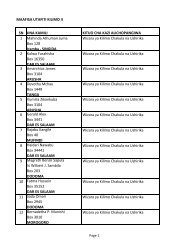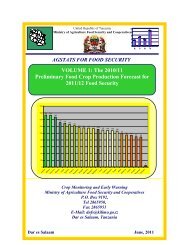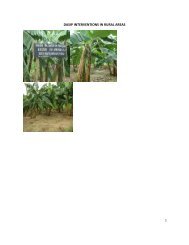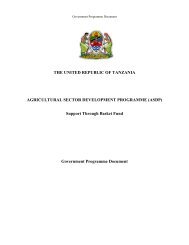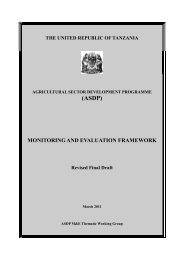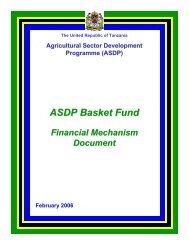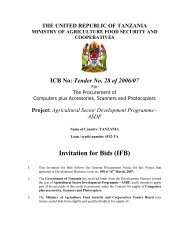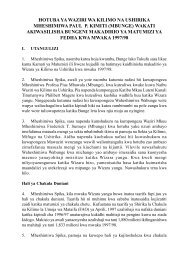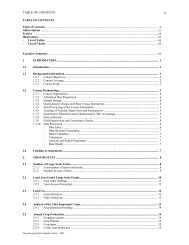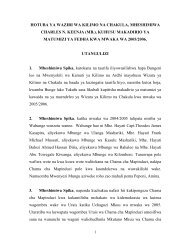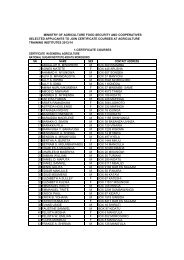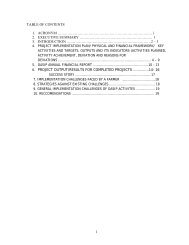ASDP: Environmental And Social Management Framework
ASDP: Environmental And Social Management Framework
ASDP: Environmental And Social Management Framework
- No tags were found...
You also want an ePaper? Increase the reach of your titles
YUMPU automatically turns print PDFs into web optimized ePapers that Google loves.
The basin is situated in the semi-arid region of Tanzania. The mean annual rainfall rangefrom 500 mm/yr at Bahi to 900mm/yr in the highlands of Mbulu district. Rainfall variesgreatly from year to year.Lake RukwaLake Rukwa basin is an internal drainage system which is described by all catchmentsdrawing into the lake with no outlet. The lake has a surface area of about 2,300 km 2 with atotal basin area of about 88,000 km 2 . Rukwa Basin may be divided into several distinctareas according to topography. The main characteristics are related to the Rift ValleySystem of East Africa.The Western part of the Lake rises rapidly to the Ufipa plateau. This area is very broken,with many small incised rivers flowing down the escarpment into Rukwa valley which runsfrom northeast to southeast. The northern side of the Rukwa Valley rises gently towardsLake Tanganyika basin. The East is dominated by the Mbeya range of mountains. TheAltitude varies from the Lake Level of 800m to 1500m a.m.s.l. on the Mbeya range.Lake Tanganyika BasinLake Tanganyika Basin is situated in the Western Part of the country. All the catchmentsthat drain in Lake Tanganyika constitute the Lake Tanganyika basin. The total catchmentsof Lake Tanganyika basin as a whole are 239.000km 2 and the area of the lake is 32,000km 2 . The land surface of the basin on Tanzania side is 151,000km 2 which contributes 60%of the total runoff to Lake Tanganyika.The basin is dominated by the Malagarasi river system which is 130,000 km 2 . The mainriver, the Malagarasi originates in the mountainous area close to the border with Burundi atan altitude of 1750 m.a.m.s.l. from where it runs northeasterly through hilly andmountainous landscape and then southward into the Malagarasi Swamps. Its majortributaries, the Myowosi and Igombe Rivers meet the Malagarasi in the seasonal LakeNyamagoma. The Ugalla and Ruchugi Rivers join the main river downstream of LakeNyamagoma. The river then runs west, through the Misito Escarpment where it forms therapids and waterfalls before entering Lake Tanganyika.The Ugalla River drains an area of approximately 52,000km 2 and before the confluencewith the Malagarasi, it passes through large areas of swamps and marshlands, forming theseasonal Lakes of Sagara and Ugalla.Other major tributaries are the Ruchugi River which drains the hilly landscape north ofKasulu, running in a southerly direction through a low, partly swampy, undulatinglandscape, before it enters the Malagarasi River at Uvinza.In addition to the Malagarasi, there are smaller basins draining into Lake Tanganyika. Tothe north west of Kigoma, the Luiche is an important river. The lower part of the river formsthe Luiche Delta which floods often during the rainy season.The rainfall regime is unimodal; there is one long wet season and a corresponding long dryseason. The wet season is from November-May and the dry season June - October. Themain part of basin has a mean annual rainfall of 800 - 1,000mm and the minimum expected25/114



